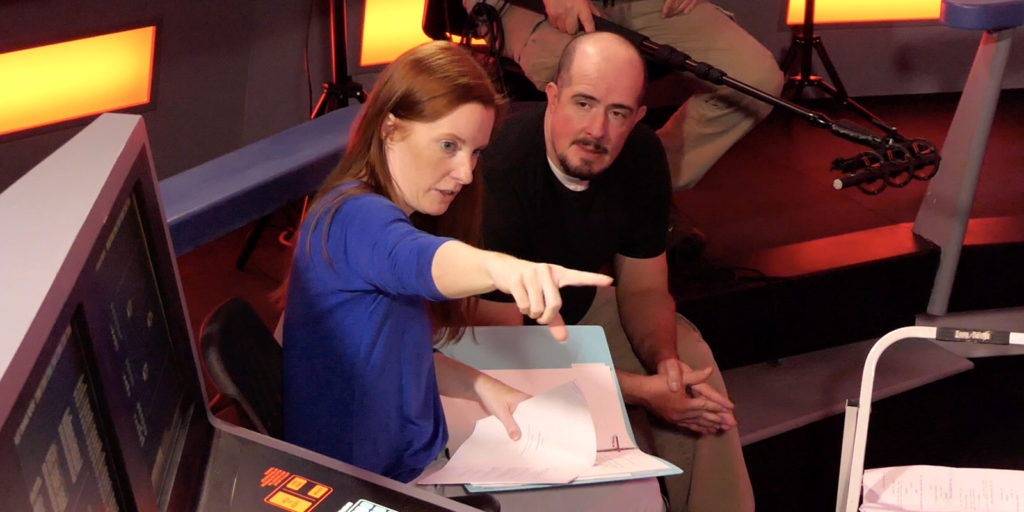
When our Axanar Universe fan film INTERLUDE is released in a few months and the credits roll, two names will appear prominently: JOSHUA IRWIN and VICTORIA FOX. And it’s because of them that Interlude will not only be an awesome Star Trek fan film but also a visual work of art.
A year and a half ago, when I first suggested to Josh the idea of shooting a fan film on the Ares bridge set, I didn’t really have much in the way of expectations other than, “It’ll be SOOOOO cool!” Y’see, the Ares Studios bridge set is just so darn awesome-looking that I figured any fan film shot on it would have to look amazing. And when Josh started talking about all of the ways he planned to light it, the angles he’d shoot it from, types of lenses he’d use, etc.—it all just zoomed completely over my head. I simply figured that my fan film was in good hands, and it was gonna be such a blast flying to Georgia and getting to watch someone shoot on those sets.
A couple of months later when I discovered that Victoria usually collaborated with Josh on their amazing AVALON UNIVERSE fan films, I invited her to come on board the project, as well…and after some discussion, she accepted. At the time, I naively thought I understood how things worked with the two of them: Josh would set up the lights and cameras (cinematography) while Victoria would work with the actors. The perfect team, splitting the tasks right down the middle.
Man, was I wrong…!
After working for more than a year with the two of them, I now understand how closely Victoria and Josh collaborate on every aspect of the films they produce together. This includes casting, discussing and planning shots far in advance, determining how much coverage to give each segment (coverage is when you shoot the same scene(s) from multiple different angles), figuring out the appropriate dramatic tone the actors should be directed to provide for the various lines, blocking (where actors stand and move to in a scene), camera angles and movements, all the way through to post-production editing, sound, VFX, and music. It’s a LOT of work, and some casual viewers who wonder, “Why isn’t your fan film finished yet?” probably don’t realize how demanding the challenges of creating a production of any kind can actually be!
Josh and Victoria began “doing their homework” for the November Interlude shoot months in advance when they first visited Ares Studios after the Treklanta con in late May of last year. They studied the set closely. Later on, SCOTT LYTTLE would photograph every console and panel. Once AXANAR had completed their first shoot at the beginning of October, Josh and Victoria asked for details on exactly how Axanar director PAUL JENKINS and his team chose to light the bridge, looking at photos to see what they liked and didn’t like. Ultimately, the two fan films will end up looking very different—even though they’re being shot on the same bridge set and with some of the same actors.
This isn’t to say that one way is right and the other is wrong when it comes to lighting. Think about all of the wonderfully different angles the original Enterprise bridge was filmed from and the various ways it was lit…
The original Enterprise bridge was a masterpiece in and of itself….as is the Ares bridge set. Victoria described it to me once as “a canvas,” but the more I thought about it, the less that metaphor seemed to fit. A canvas typically starts out blank. The Ares bridge is far from blank! There’s color and light and animations and shapes and textures already there for a director and/or cinematographer to play with in any way he or she wants to.
My analogy would be more of a “fully-stocked kitchen”…filled with every single ingredient you could possibly want: the finest meats and fish, the freshest vegetables, every herb and spice you might need. All you have to bring are the the culinary tools of the craft and the recipes you want to follow. In such a kitchen, some folks might make a simple grilled cheese sandwich…and likely a very delicious one. Others might make more exotic dishes with complex flavors and elaborate presentations. And as I said, there’s no wrong answer.
Josh came into the shoot with a specific vision, which he explained to me briefly on camera before setting up…
And ultimately, Josh and Victoria came up with a mixture of both unique compositions along with some VERY classic Star Trek-like shots both in terms of lighting and camera angles. In one case, Josh worked super hard with the lighting to recreate a glow on the captain’s eyes that was originally seen in “Balance of Terror”—and I think he nailed it…
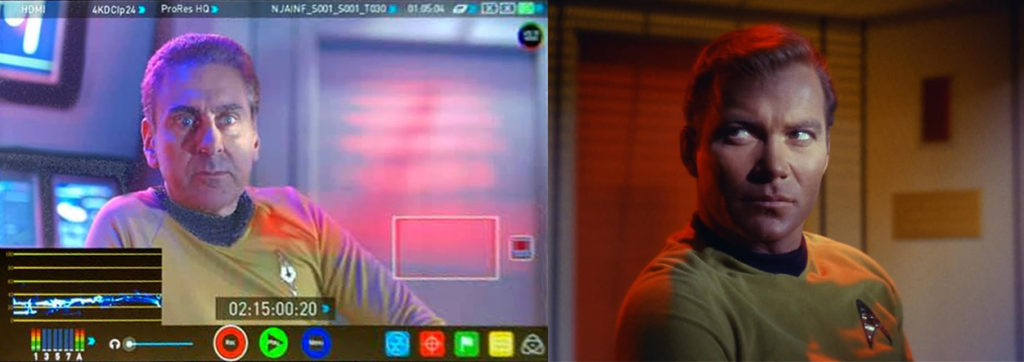
You might notice from the above photos that the Ares bridge is lit pretty darkly. That’s no accident! Interlude features two starships—Ares and Artemis—and although both are taking a pounding from the Klingons, the directors and I agreed that Ares is the way more damaged of the two. Therefore, the lights are lower since main power is being prioritized to shields and propulsion at the moment. As a comparison, this is the way that the Artemis will look…
And as a third comparison, here’s one of the bridge scenes from the two Axanar sequels…
As I said, there’s no right or wrong way to light this amazing set. In fact, the true beauty of the Ares bridge (or whatever starship you might want it to be) is that it allows a director’s and cinematographer’s creative vision to materialize and manifest in so many wonderful and diverse ways.
With the cinematography in place, the next major job was to ensure that the actors all turned in performances that followed and also enhanced the lines written in the script, and that is where Victoria shines most brightly.
Victoria is a trained and experienced actor—and in fact, she’s got a small on-camera part herself in Interlude. But for the Ares Studio shoot in November (and again in March), Victoria’s main role was that of directing the actors. And for me, I found watching the entire process through two 12-hour days of prepping and shooting last November to be utterly fascinating and very exciting.
Now, I might not know much about the art of directing actors, but there is one thing that I do know (because Victoria told me): actors do NOT appreciate line readings. A line reading is when the director walks up to an actor and recites the line for the actor, adding, “Say it exactly like I just did.” Actors HATE that! It’s insulting to the actor and takes them out of the moment when they deliver the line. Instead of giving their own performance, they’re just mimicking and providing a second-hand version of the director’s delivery. Might as well hire a trained parrot!
So how does a director manage to get just the right performance they want without demonstrating for the actor exactly how they’d like it done? Ah, that’s where the subtle craft of directing comes into play (or one of many places it comes into play, I’m sure!). And watching Victoria do just that was very eye-opening.
Victoria explained to me that every actor is different, and there is no “cookie-cutter” approach. What works with one actor might not work with a different actor, and the skill and effectiveness of a director lies in figuring out what an actor can best connect with. Just giving them a series of instructions often winds up with the actor over-thinking and not being in the moment. So instead, give them an opportunity to draw out something from their own experience(s). If the director can accomplish that, the actor can usually handle the rest and provide a more convincing performance. But there’s no one single way to accomplish that. “Art cannot, by its very nature, be formulated,” Victoria told me.
I shot literally hours of on-set video footage during the November shoot, and after Interlude is released, I’ll be putting together some behind-the-scenes blogs so you can get a first-hand view of things yourself. But for right now, I have one 4-and-a-half-minute sequence of Victoria directing that doesn’t contain any significant spoilers.
What you’re about to see is short glimpse into our Sunday shoot on the bridge of the USS Ares. In the shot are ALEC PETERS as Garth and ROBERT HAYES as Deville, the Ares pilot (along with a couple of background players). Victoria and Josh had already gotten close-up and wider coverage on Garth giving Deville an order, and now it was time for Deville’s response in a shot framed primarily on Deville with Garth behind him.
For this scene, Deville is steering the ship and dodging the Klingons’ weapons, but he’s also marveling at these new D7 “monsters” and how fast they are. The challenge for Robert (playing Deville) lies in where to look as he’s delivering his lines.
As you can see from the photo above, the Ares helm console is very eye-catching—and it’s really hard NOT to look at it! The goal for Victoria was to have Deville first look at the console and then finish his line by lifting his head up to look at the view screen (and by doing that, at the camera).
As you’ll see from the early takes in the beginning of the video below, Robert is a little “inside his head” with the instructions. Initially, Robert’s timing is a little off, and then, once Robert looks up, he freezes his gaze, and the performance feels unconvincing. So how does a director course correct the helmsman without burying him in ever more onerous instructions that will push him even further from being in the moment?
Despite Robert being a trained actor, few performers ever get to pilot a starship—either fictionally or in real life—and so they don’t necessarily have real-world experiences to draw from. That’s where a good director can make all the difference. As you’ll see in the video at about the 1:50 mark, Victoria keys in on the perfect analogy to provide Robert something familiar to connect with: “Do you have to look at the steering wheel when you drive your car?”
I thought it was a brilliant directing cue. So did just about everyone else there, including Axanar director PAUL JENKINS, who had stopped by the studio to visit and watch the magic being made. And now you can watch a little bit of it, too…
What you can also see from the above video is how Victoria and Josh collaborate seamlessly. Josh has already done his part in setting up the shot—lights, camera, etc.—and now Victoria takes over to direct the actor(s). But along the way, they briefly discuss both what they want from the shot and what they’re getting and not getting. In this way, the dynamic directing duo is refining the scene until it’s “perfect.” You can also hear our 1st Assistant Director, JOSH WILCOX, letting the folks on set all know what’s happening (he’s the one who actually yells “Action!”). It’s a fascinating ballet of many simultaneous moving parts.
Now, some of you might be wondering, “Why go through all of this trouble just for one head tilt?” After all, the first few takes aren’t necessarily bad. Why commit precious time and energy to the smallest of motions that’ll last only a second in the finished film and that no one will probably ever notice? That’s probably the kind of question that most directors ask…whether they’re shooting a fan film or a regular film. For Victoria and Josh, they knew the shot they wanted and felt it was worth a few extra minutes to get it the way they envisioned it. Other directors might have decided differently. But I personally appreciated the keen attention to detail, and as I’ve seen the final edit, Deville’s shot really does look great and is very believable.
The entire weekend was full of moments like this…with everyone from the main actors—Alec and WARREN HAWK (who plays Captain Jakande)—to the supporting actors like Robert to the background players who had more to do than simply sit around and press fake buttons. Everyone got Victoria’s attention. And it’s really gonna show when Interlude is finally released.


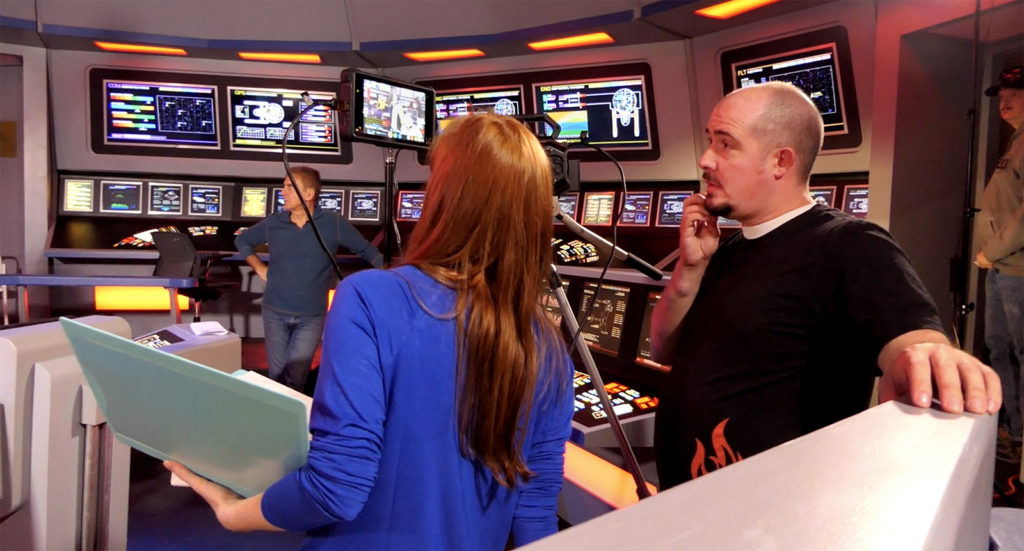
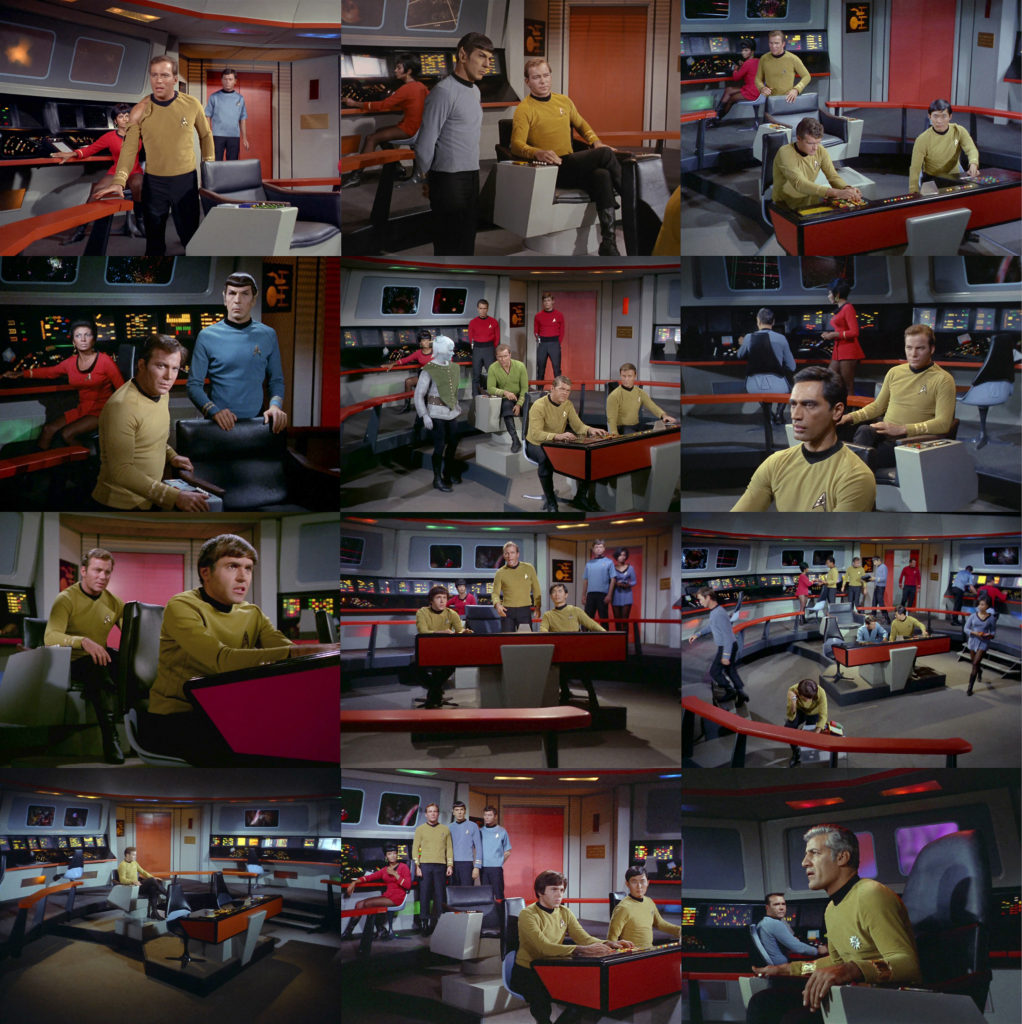
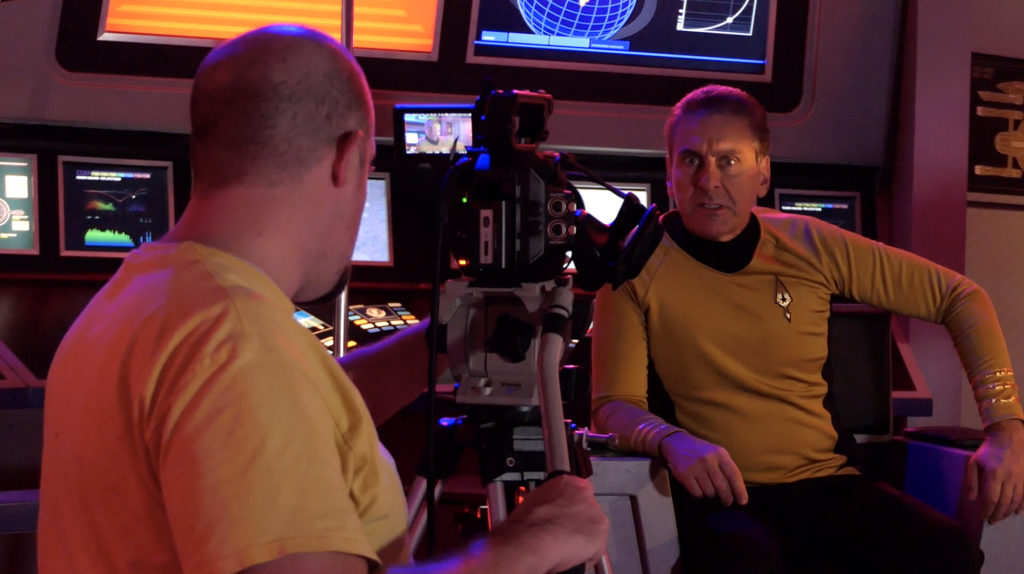
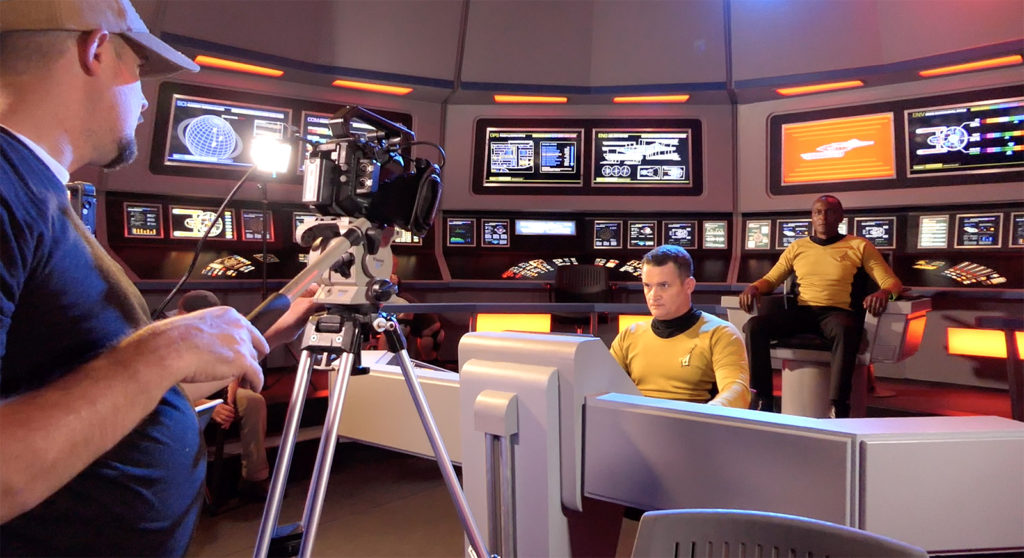
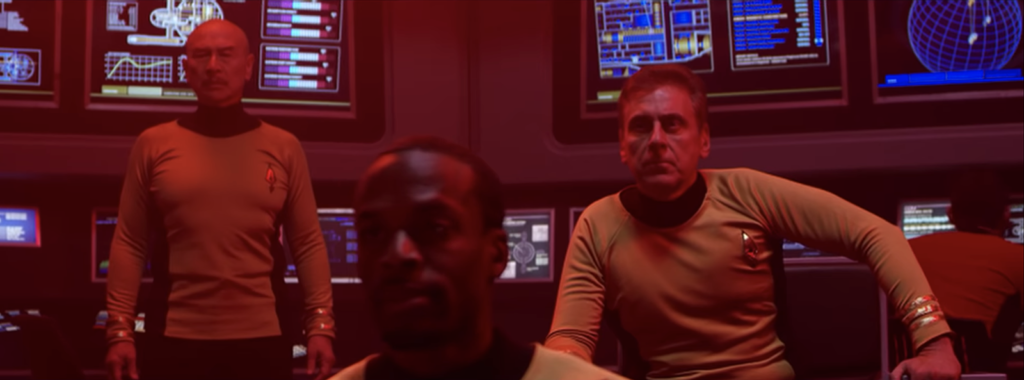
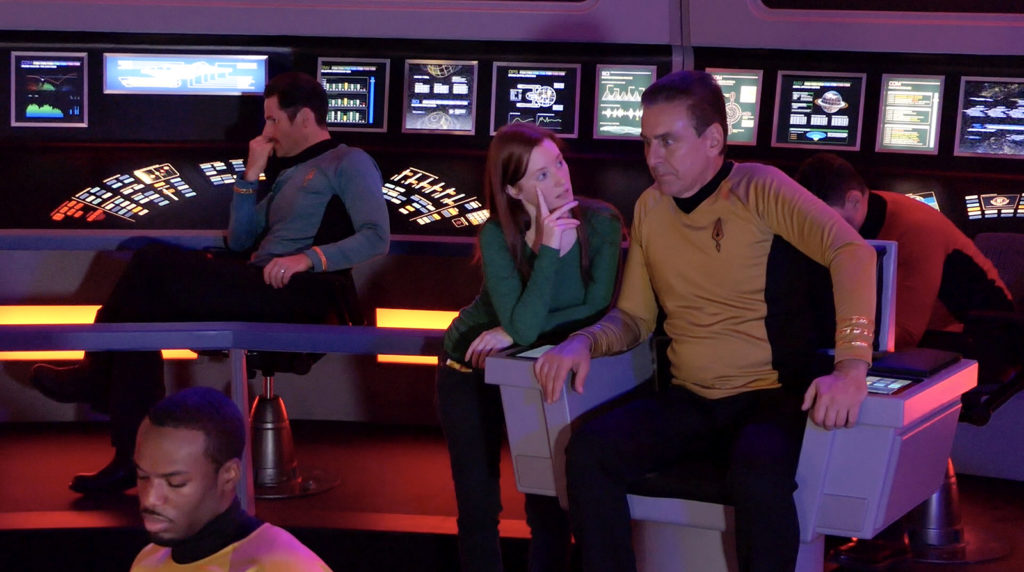
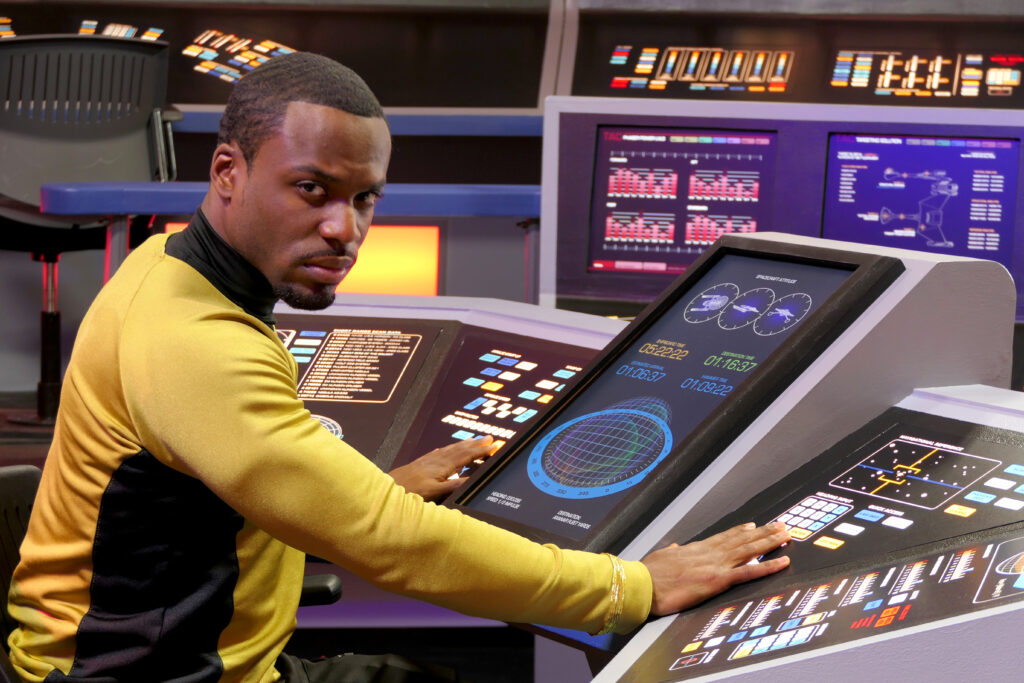
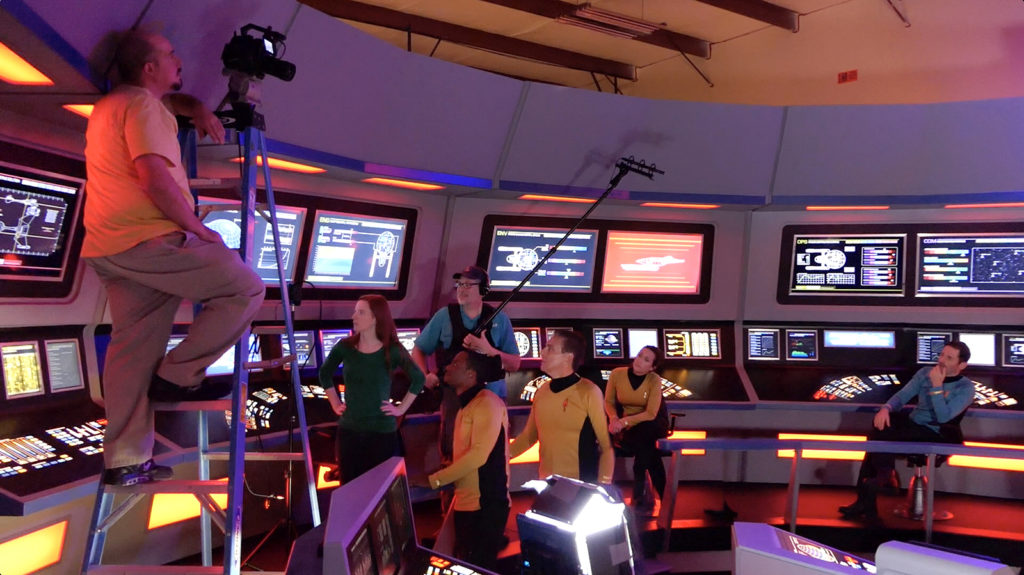
“Why commit precious time and energy to the smallest of motions that’ll last only a second in the finished film and that no one will probably ever notice?”
Consciously notice? Probably not outside of a very few. But there are some, most likely those “in the business”, that might notice. My wife plays an instrument and notices every detail about how another player of that instrument moves his or her fingers and hands. I don’t notice but she does.
And little details like that contribute to the scene feeling real just as in a concert tiny details separate a great performance from a wooden one.
I’m a graphic designer by trade and training (among other things), and I’ll spend hours fretting over the font selection, a color shift from turquoise to aqua or from canary yellow to lemon yellow, or the letter spacing, or the placement of a photo millimeters to the left or right.
In the end, all of these tweaks are never noticed by the non-designer…and indeed, if all my hard work is NOT noticed, that means I’ve done my job correctly! 🙂
Here ia a question Jonathan perhaps you can even expand it into an article if you think that there is sufficient interest it is also one on which you are uniquely qualified to answer.
You have produced a 10 minute fan film for $20,000 very simple maths shows a cost of $2000 a minute. Some fan films cost a lot more some less even.
If we take a guesstimate on the current offerings from Disney at $8 million for 42 minutes it comes out at $190,000 a minute 95 times as much.
Now they are using professionals of course but Professionals by their very nature are more productive they get the job done quicker. Which of course actually drives down costs.
Of course the issue of quality is both objective and subjective I can say that subjectively I am looking forward to your 10 minute film more than the last 3 seasons of CBS offerings whilst still acknowledging that that the quality of the production of these 3 seasons and some of the acting is definitely superior to what you will produce.
So why the massive gap in costs? Certainly the professionals deserve to get paid for their time and effort yet why the disparity I would expect 10 times even 20 times yet nearly 100 times! If CBS had shot your film the cost would of been nearly $2 million. I do not know nearly enough about film production but I am going to guess that you used 20 or 30 people but a studio would of used 100 or more people as well. However overmanning still does not account for such a large gap.
Hmmmm…that’s a tough one to answer as I’ve only ever produced one film! I have no idea how much things cost for a real studio production. Obviously, I had a lot of people working for peanuts (literally) and/or free meals. My costs were more practical things like equipment rental, gas and lodging, costumes, make-up supplies, catering…the list goes on and on. Real movies and TV shows have those hard costs, too, and pay salaries that range from production assistants making minimum wage and extras at $50 or $100/day, to mid-level production members like key grips and gaffers and sound engineers probably making about $300-$400/day, to the producers and directors who might be making a thousand dollars a day or more. And of of course, the actors might be making in the tens or hundreds of thousands of dollars (I’m sure Sir Patrick’s salary had an additional zero at the end).
Aside from that, yes, Hollywood studio productions employ a LOT of people. I had about 55 folks all told (most on set), but about a third were extras. So really, I had more like 35 people working on Interlude. And there were a lot of people I did NOT have. I had an assistant director but no second assistant director. There was no supervising producer to keep track of budget (I did that as executive producer; I wore a lot of hats). Victoria doubled as casting director. Josh is both DP and editor. Lewis is doing VFX, but there’s no specific Post Production Supervisor. I’ve kinda doubled up on that role, as well. And Lewis is his own VFX Supervisor ’cause he knows way more about CGI than I ever will.
Anyway, I’m sure Josh or Victoria could provide you a way better answer than I ever could. But I will also mention one last thing. We filmed the entire Interlude project on just two sets and two green screens. There was no on location shooting. There was no need for a location scout or excessive travel for cast and crew to different locations. Our biggest travel expenses were Josh, Victoria, and Earl back and forth from Arkansas to Georgia, David Agrinsonis from Cleveland to Arkansas, and Steven Jepson from Missouri to Arkansas (oh, and me from L.A. to Georgia…which donor money did NOT pay for). Larger productions like Picard might have to keep an entire 200-person production crew in, say, Solvang for nine days of filming at the Sunstone Winery Villa. That’s a lot of trucks, a lot of meals, and a lot of hotel rooms! And possibly a lot of overtime!
Anyway, the shorter answer would simply be, “Hey, it just is what it is.” 😉